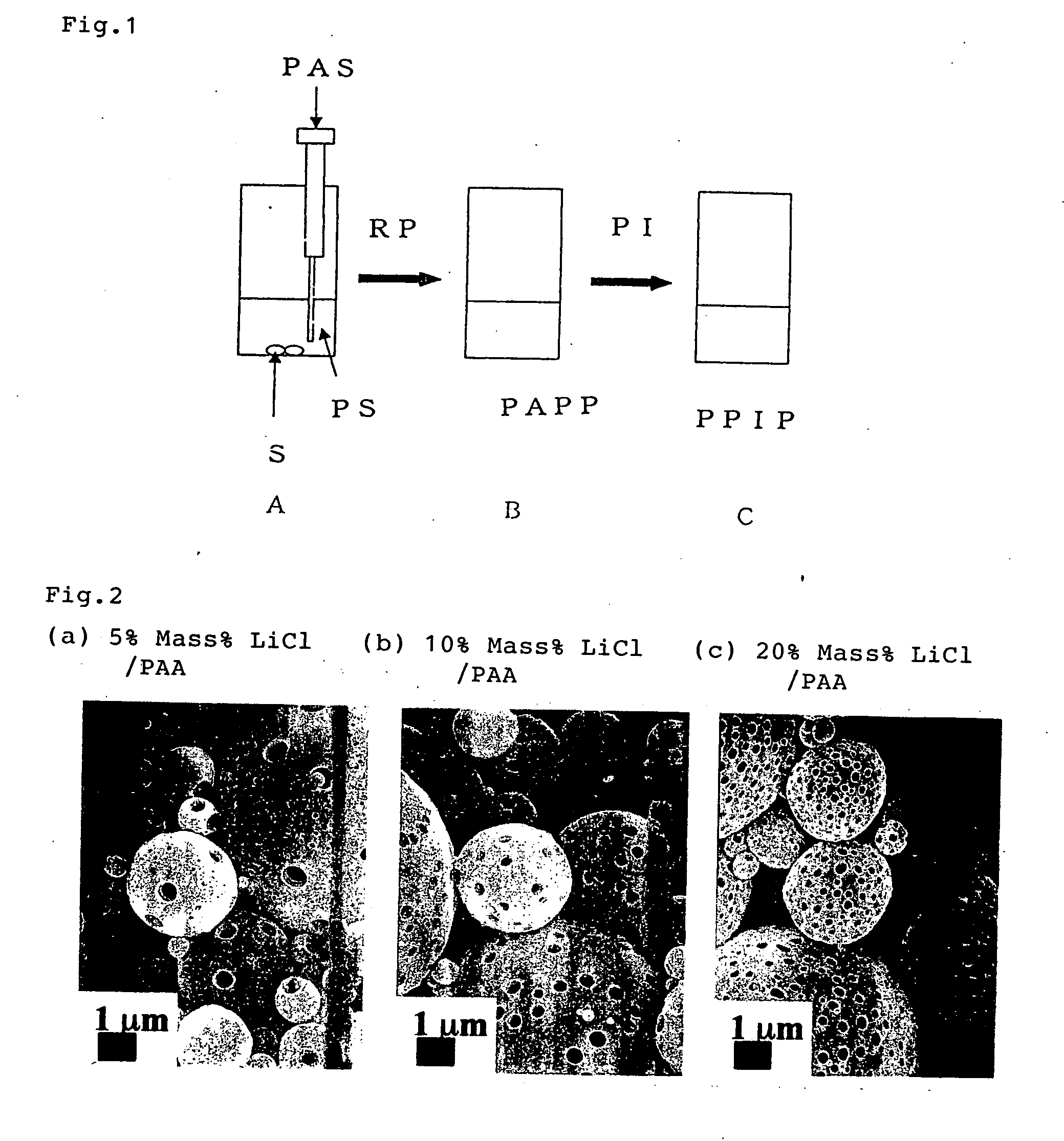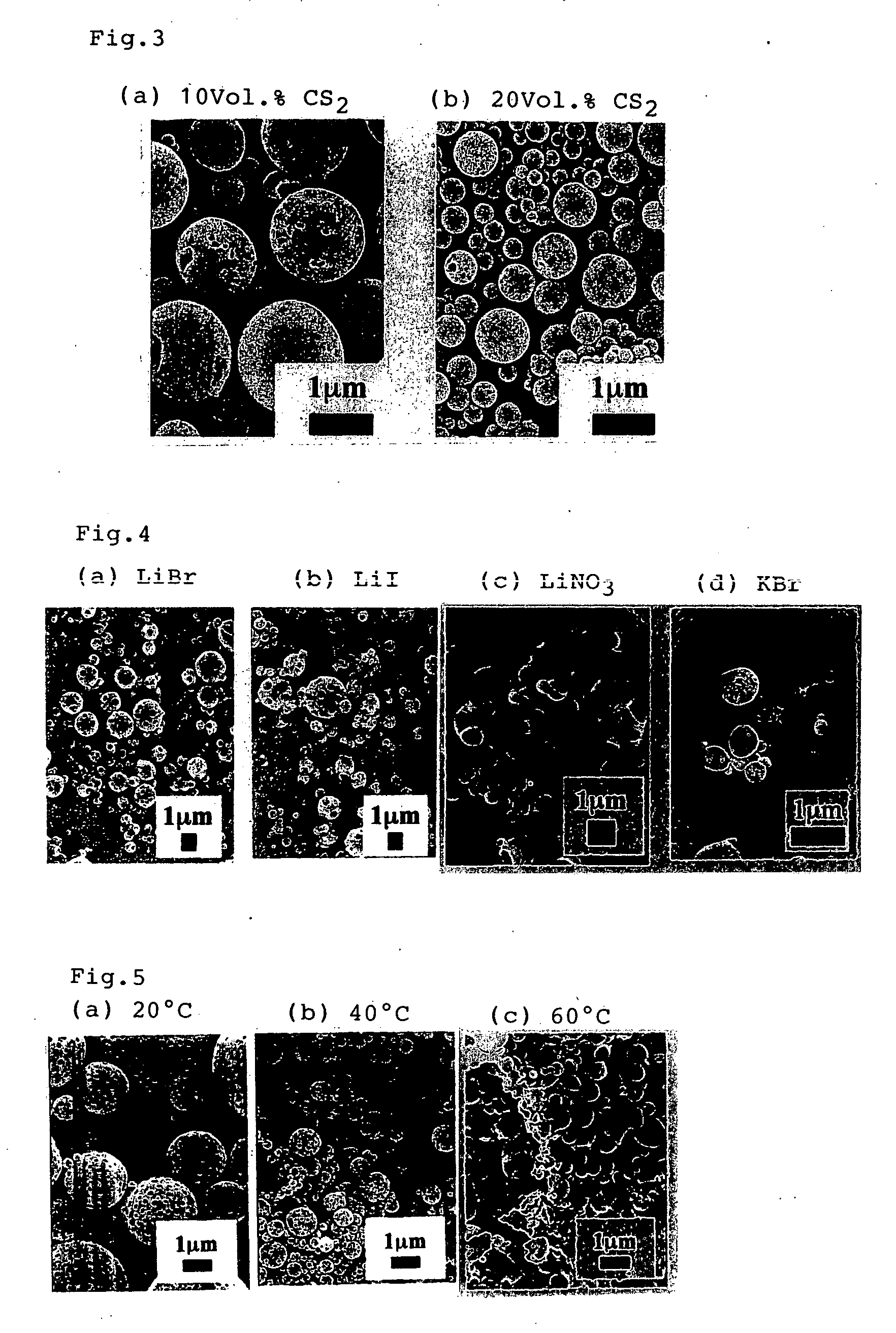Process for producing fine porous polyimide particle
a technology of porous polyimide and microparticles, which is applied in the directions of powder delivery, pharmaceutical delivery mechanism, medical preparations, etc., can solve the problems of poor reproductivity, difficult control of preparation conditions, and difficult selection of solvents
- Summary
- Abstract
- Description
- Claims
- Application Information
AI Technical Summary
Benefits of technology
Problems solved by technology
Method used
Image
Examples
example 1
[0024] Polyamide acid (molecular weight: 68650) obtained by polymerization of 2,2-(3,4-dicarboxyphenyl)-1,1,1,3,3,3-hexafluoropropane dianhydride and 4,4-diaminodiphenyl dissolved in NMP (afore mentioned Acrydic: containing 0.1 weight %) by 1.54 weight %, then solutions are prepared so as the blending amount of LiCl to polyamide acid contained in polyamide solution to be 5 mass % (a), 10 mass % (b) and 20 mass % (c) / polyamide acid. 0.1 ml of said prepared solutions are respectively poured into 10 ml of cyclohexane by a microsyringe under stirring condition of 1500 rpm at room temperature. Porosity of formed porous polyamide acid microparticles becomes larger along with the increase of blending amount of LiCl.
[0025] 0.1 mL of mixed solution of pyridine / acetic acid anhydride whose molar ratio is 1 / 1 is added to above porous polyamide acid microparticles dispersion by stirring then continue the stirring for about 2 hours, thus chemical imidation is completed. Porous polyimide micropar...
example 2
[0026] Polyamide acid (molecular weight: 68650) obtained by polymerization of 2,2-(3,4-dicarboxyphenyl)-1,1,1,3,3,3-hexafluoropropane dianhydride and 4,4-diaminodiphenyl dissolved in NMP (afore mentioned Acrydic: containing 0.1 weight %) by 1.54 weight %, then LiCl of 20 weight % is added to polyamide acid. 0.1 ml of said obtained solution is poured into cyclohexane mixture (10 ml) to which 10 vol % (a) or 20 vol % CS2 is added using a micro syringe at room temperature under stirring condition by 1000 rpm. Particle size and porosity of formed porous polyamide acid microparticles become small along with the increase of blending amount of CS2.
[0027] To the obtained porous polyamide acid microparticles dispersion, 0.1 ml of mixed solution of pyridine / acetic acid anhydride by 1 / 1 molar ratio is added with constant stirring, that is, chemical imidation to maintain said condition for about 2 hours is carried out, then thermal imidation to maintain the temperature of 250° C. for 3 hours i...
example 4
[0030] Polyamide acids having various molecular weights: (8000, 48000, 69000, 93000, 220000) obtained by polymerization of 2,2-(3,4-dicarboxyphenyl)-1,1,1,3,3,3-hexafluoropropane dianhydride and 4,4-diaminodiphenyl dissolved in NMP (afore mentioned Acrydic: containing 0.1 weight %) by 1.54 weight %, then solutions are prepared so as the blending amount of LiCl to polyamide acid contained in polyamide solution to be 20 mass % / polyamide acid. 0.1 ml of said prepared solutions are respectively poured into 10 ml of cyclohexane by a microsyringe under stirring condition of 1500 rpm at room temperature.
[0031] To said porous polyimide microparticles dispersion, 0.1 ml of mixed solution of pyridine / acetic acid anhydride by 1 / 1 molar ratio is added with constant stirring, that is, chemical imidation to maintain said condition for 2 hours around is completed and porous polyimide acid microparticles maintaining porous properties of the porous polyamide acid microparticles are obtained. Porous...
PUM
| Property | Measurement | Unit |
|---|---|---|
| Temperature | aaaaa | aaaaa |
| Temperature | aaaaa | aaaaa |
| Fraction | aaaaa | aaaaa |
Abstract
Description
Claims
Application Information
 Login to View More
Login to View More - R&D
- Intellectual Property
- Life Sciences
- Materials
- Tech Scout
- Unparalleled Data Quality
- Higher Quality Content
- 60% Fewer Hallucinations
Browse by: Latest US Patents, China's latest patents, Technical Efficacy Thesaurus, Application Domain, Technology Topic, Popular Technical Reports.
© 2025 PatSnap. All rights reserved.Legal|Privacy policy|Modern Slavery Act Transparency Statement|Sitemap|About US| Contact US: help@patsnap.com


